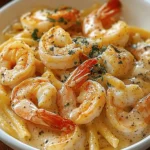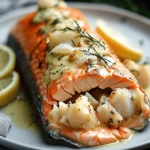The refined elegance of Gordon Ramsay’s Lobster Salad lies in its minimalism fresh lobster meat, bright lemon, tender celery, and aromatic chives, all gently folded with just enough mayo to bind. Each bite is a balance of creamy and crisp, rich and tangy, tender and snappy. Served chilled, it’s the epitome of a refreshing summer seafood dish.
Whether nestled into buttered brioche, spooned delicately into crisp lettuce cups, or fanned over avocado slices, this lobster salad is a luxurious but simple way to elevate your meal. With thoughtful ingredient selection and a few chef’s tricks, it transforms into something unforgettable clean, elegant, and incredibly satisfying.
Full Recipe:
Ingredients:
-
1.5 lbs cooked lobster meat, cut into ¾-inch chunks (preferably claw and knuckle meat)
-
⅓ cup mayonnaise (neutral and not overly rich)
-
1½ tbsp fresh lemon juice
-
¼ cup finely chopped inner celery stalks
-
1 tbsp thinly sliced fresh chives
-
Salt and freshly cracked black pepper, to taste
Directions:
-
In a chilled metal mixing bowl, add the lobster meat, mayonnaise, lemon juice, chopped celery, and chives.
-
Gently fold the ingredients together using a rubber spatula avoid overmixing to keep the lobster chunks intact.
-
Taste and lightly season with salt and freshly cracked black pepper. Mix again gently.
-
Cover the bowl and refrigerate for 30 to 60 minutes to allow the flavors to meld and the dressing to firm slightly.
-
Serve cold in lettuce cups, toasted brioche buns, or spooned over avocado slices or cucumber rounds for a refreshing appetizer.
Prep Time: 20 minutes | Chill Time: 30 minutes | Total Time: 50 minutes
Kcal: 300 kcal | Servings: 4
Gordon Ramsay’s Lobster Salad: The Art of Restraint, Flavor, and Texture
There’s something undeniably luxurious about lobster. From its buttery tenderness to its slightly sweet oceanic flavor, lobster is a centerpiece ingredient that demands respect. And when one of the world’s most respected chefs, Gordon Ramsay, creates a dish around it, you know the result is going to be a masterclass in culinary balance.
Ramsay’s take on lobster salad isn’t just another seafood dish it’s a brilliant example of how restraint, precision, and respect for ingredients can turn something simple into something sublime.
In this article, we explore why this lobster salad works so well not through its recipe steps, but by diving into the chef’s mindset, ingredient synergy, texture contrasts, and modern plating approaches that make it a stand-out seafood dish worth replicating.
Understanding Ramsay’s Philosophy: “Don’t Ruin the Ingredient”
The first and most important lesson in Gordon Ramsay’s lobster salad is this: when you have incredible ingredients, your job is not to ruin them.
That sounds straightforward, but in practice, it requires discipline. Lobster, particularly claw and knuckle meat, is delicate. It doesn’t need to be buried under rich sauces or hidden behind overpowering flavors. Ramsay’s approach is to frame the lobster, not smother it.
He treats lobster as a hero ingredient and focuses on subtle enhancements mild acidity, gentle creaminess, and just enough crunch to elevate, not distract. The brilliance of the dish is in its restraint. It’s not showy; it’s intentional. Ramsay teaches that good cooking isn’t just about adding sometimes it’s about holding back.
The Role of Texture: Creamy, Crisp, and Clean
Texture is one of the most overlooked elements in home cooking. Ramsay’s lobster salad is an excellent study in textural contrast. Each bite is meant to deliver a play of sensations: the soft, rich lobster; the slight firmness of finely diced celery; the smooth creaminess of mayo; and the refreshing snap from chilled greens or cucumber when served.
The difference between a dull salad and a dynamic one often lies in how the textures interact. If the celery is stringy, the lobster chewy, or the salad too wet, the entire experience falls apart. Ramsay emphasizes control here cutting lobster into just the right size, using the inner stalks of celery for tenderness, and mixing everything just enough to combine without breaking down the lobster.
In the final plating, this contrast continues. Whether served in crisp lettuce cups or on top of creamy avocado slices, the textures are always deliberate and balanced.
The Importance of Acid: Precision, Not Power
In many seafood dishes, acid is the balancing force that brings freshness and cuts through richness. But too much of it can be just as problematic as too little. Ramsay’s rule? “Use acid like a chef’s knife precise, not poured.”
The acid in this lobster salad usually comes from lemon juice, which brightens the dish and enhances the natural sweetness of the lobster. The trick, however, lies in measured acidity. Just a tablespoon and a half is enough to do the job without overwhelming the palate. More than that, and the dressing can quickly turn harsh, especially if paired with delicate shellfish.
This delicate balancing act between fat and acid is a hallmark of Ramsay’s cold seafood preparations. It elevates the salad from something rich and cloying into something refreshing, light, and satisfying.
Why Most Lobster Salads Go Wrong
Most lobster salads fail because they forget that lobster is a luxury product. It’s not tuna salad. You can’t just load it up with mayo, toss in chunky vegetables, and call it gourmet.
Here’s where things usually go wrong:
-
Too much mayonnaise: Overwhelms the palate, masks the natural flavor of the lobster, and leaves a greasy mouthfeel.
-
Over-chopped or under-chopped lobster: Inconsistent bite sizes make for uneven flavor distribution and poor texture.
-
Using bitter, stringy celery: Outer stalks can add unwanted bitterness and chewiness.
-
Overmixing: This breaks down the lobster and turns the dressing into paste.
-
Skipping the chill time: Serving the salad warm ruins the clean mouthfeel. Chilling not only firms up the dressing but also marries the flavors.
Ramsay’s approach corrects each of these issues with surgical precision. It’s a recipe that not only tastes good but also teaches you how to cook smarter.
A Canvas for Creativity: Variations That Work
While Ramsay’s lobster salad is beautifully minimalist, it also allows for creative expression when done with care. For example, a small amount of diced green apple can add a sweet, tart crunch that pairs well with lemon and celery. Or, crème fraîche can be used in place of mayo for a lighter, tangier profile particularly good in hot weather.
Other subtle additions like a dash of Dijon mustard (when serving the salad in a brioche bun) can add depth without overtaking the flavor. What Ramsay avoids and wisely so are overpowering herbs like tarragon or red onion, which can hijack the dish’s delicacy.
Even the way you present the salad can vary. Serve it in buttered brioche for a decadent lobster roll, in lettuce cups for a low-carb option, or even spooned over grilled asparagus or thin avocado slices for elegant plating. The format may change, but the discipline remains.
Pro Tips From a Chef’s Playbook
Some of the most valuable parts of this dish come not from the recipe itself, but from the pro techniques behind it. Here are a few key insights:
-
Use claw and knuckle meat: It’s more tender than tail meat and holds up better when chilled.
-
Chill your mixing bowl: A cold metal bowl helps keep the dressing from separating and ensures a refreshing finish.
-
Salt at the end: Salt draws moisture, which can ruin the texture if added too early. Season gently and taste as you go.
-
Toast your bread with clarified butter: If you’re serving this in a roll, this step adds a buttery crunch that pairs perfectly with the creamy salad.
-
Dry your lobster: Especially if using thawed lobster meat. Excess moisture will dilute the dressing and flatten the flavor.
These are the kinds of subtle, professional touches that elevate a home-cooked dish to restaurant quality.
Why This Dish Matters
At first glance, Gordon Ramsay’s lobster salad might seem like a basic recipe. But look a little deeper, and it becomes clear that it’s a masterclass in culinary fundamentals.
It demonstrates how to:
-
Let ingredients shine
-
Balance richness with brightness
-
Create textural contrast
-
Practice restraint and precision
-
Plate with purpose
It’s a rare dish that’s both easy enough for a home cook and refined enough to serve at a dinner party. And it’s exactly this blend of simplicity and sophistication that defines great cooking.
Conclusion:
In the end, Ramsay’s lobster salad is more than just a refreshing dish it’s a culinary philosophy served cold. It reminds us that luxury isn’t always about excess. Sometimes, it’s about knowing when to stop. When to let the ingredients speak. When to trust that subtlety will do more than spectacle ever could.
For home cooks, this recipe is an invitation to think differently about seafood salads. For food lovers, it’s a reminder of what real flavor balance looks like. And for anyone who has ever drowned lobster in mayo and wondered why it tasted like “fancy tuna mush,” it’s a revelation.
This salad isn’t just worth making. It’s worth learning from.






